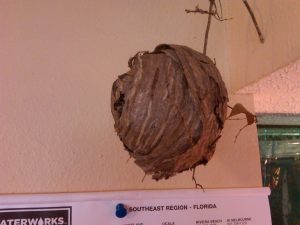At the end of every summer & begining of fall, pest control firms across North America get the frantic call of giant hornets nests that seem to have appeared out of nowhere. The lucky homeowners, spot the nest as perhaps leaves begin to fall and foliage starts to thin. Others stumble upon this football shaped behemoth while trimming and have a painful reminder forever etched in their minds as to how aggresive and powerful this stinging pest can be. It’s always amazing how for months we walked right by this growing menace never knowing the danger that lurked.
D. maculata (Dolichovespula maculata) is commonly referred to as The Bald Faced or White Faced Hornet due to it’s white skelital looking face. The old nests are never reused and each year new fertilized queens wake from over wintering and begin the task of finding and making a home. When the first few eggs hatch and then go through the larval and pupal stage, the brand new workers take over the task of nest building and gathering food. The nest is made from chewed up wood and hornet saliva and is spread out in thin layers and becomes a papery substance when dry. The small nest is easy to over look and is quite often located in shrubs around the home or in trees. At times the nest can be located in the eaves or other suitable place on the home but they more often prefer the former. As the nest grows the construction continues around twigs and branches. This gives the queens castle stability but can make removal of an active nest quite difficult.
At summers end activity is at its peak. This already aggressive hornet may be a little less forgiving if you wander to close and can and will sting intruders repeatedly to protect the nest. When the cold weather hits, all the hornets die except this years newly fertilized queens. These females will hibernate in the ground or under logs or in a suitable void. The cycle begins a new in the spring.
can and will sting intruders repeatedly to protect the nest. When the cold weather hits, all the hornets die except this years newly fertilized queens. These females will hibernate in the ground or under logs or in a suitable void. The cycle begins a new in the spring.
If you spot one of these huge nests on your property you could always mark the area, stay away until the cold winter sets in and then safely bag a trophy that looks great in any den. If there is however any danger of humans or pets getting stung, my best advice is to call in a pro to have the nest removed and/or destroyed. The following video is a ‘how to’ for newer pest control technicians that may need instruction on how this is done. Homeowners who decide to this on their own- well you’ve been warned.




